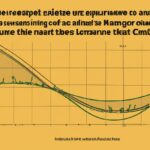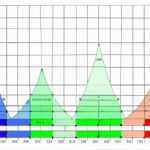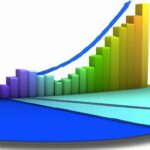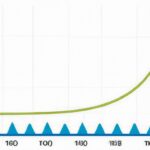While the Gini coefficient is widely used to measure income inequality, there are other methods available. Researchers explore diverse approaches like the Palma ratio, which compares the income share of the top 10% to the bottom 40%. Another alternative is the 80/20 ratio, focusing on how much of the national income the top 20% earn. The Atkinson index is also meaningful, emphasizing income distribution among different sections of society. These alternatives offer valuable insights into inequality beyond the limitations of the Gini coefficient. Each method has its strengths and weaknesses, providing a more comprehensive understanding of economic disparities.
Table of Contents
(Gini Coefficient and Lorenz Curve)
The Gini coefficient, widely used to measure income inequality, has its limitations. Luckily, several alternatives offer a more comprehensive understanding of inequality. The Palma ratio, a simple method, compares the income share of the top 10% to the bottom 40%. Similarly, the 20/20 ratio compares the top 20% to the bottom 20%, emphasizing the middle earners. The Theil index breaks down inequality into within-group and between-group components, providing a nuanced perspective. Atkinson index integrates societal preferences to weigh income distribution, offering a socially conscious approach. Additionally, the Hoover index focuses on the extent of income distribution rather than just its equality, giving a multifaceted view. Despite these alternatives, each metric has its strengths and weaknesses, highlighting the complexity of measuring inequality. Therefore, a combination of different indices may offer a more holistic understanding of wealth distribution. By utilizing these diverse tools, policymakers and researchers can gain deeper insights into income inequality, facilitating the development of targeted interventions that address societal disparities effectively.
Atkinson Index
When delving into measures of income inequality, the Atkinson Index emerges as a compelling alternative to the widely-known Gini coefficient. Picture this: while the Gini paints a broad stroke by summing up disparities in one value, the Atkinson hones in on distribution nuances that often go overlooked.
The beauty of the Atkinson lies in its sensitivity to changes at different points along the income spectrum. Imagine you’re watching a delicate dance where each move matters – that’s what this index does. It assigns varying weights to different parts of income distribution, capturing not just how unequal things are but also where those inequalities hit hardest.
Let me paint you a clearer picture: think of society as an intricate tapestry woven with threads of varying thicknesses and colors. The Gini might give you a bird’s eye view, noting some areas are darker or lighter than others. But switch over to the Atkinson lens, and suddenly you’re zooming in, noticing subtle shifts and gradients invisible before.
Emotions can run high when discussing income inequality – it’s about people’s lives after all! The Atkinson steps onto this stage like a skilled actor ready to embody nuance and depth. It says, “Yes, there is inequality here” but then adds whispers like “Look closer… see how deeply it cuts for some.”
And let’s talk numbers for a moment without losing our emotional thread – because these figures matter! Unlike the Gini which sums up everything into one value hanging above us like Damocles’ sword – ominous yet detached – the Atkinson breaks down complexities into digestible bites. Each slice tells us something crucial about who bears the brunt of economic disparities.
Imagine being an economist trying to understand more than just surface-level inequalities; imagine wanting insights that could inform policies addressing real struggles faced by real people every day. That’s where the magic lies with our friend, Mr.Atkinson!
So next time someone mentions measuring income disparity don’t settle for black-and-white snapshots—dive deeper with an ally like our nuanced hero,the Atkinson Index!
Hoover Index
When delving into alternatives to the Gini coefficient, one crucial measure that stands out is the Hoover Index. Picture this: you’re navigating through a maze of income inequality indicators, and suddenly, you stumble upon an intriguing concept—the Hoover Index. It’s like finding a hidden gem among statistical measures.
The Hoover Index offers a unique perspective on income distribution by focusing on relative differences at various points along the income spectrum. Imagine looking at society through a different lens where not just extremes matter but every step within the economic ladder holds significance.
Unlike its counterparts, the Hoover Index doesn’t stop at merely comparing rich versus poor; instead, it investigates how disparities change across all income levels. It’s as if you are zooming in with precision to uncover nuances that other metrics might overlook—a closer examination revealing patterns and intricacies of wealth distribution dynamics.
As you immerse yourself in understanding this index, emotions may stir within you—perhaps curiosity piqued by its intricate nature or awe inspired by its ability to unveil subtleties in societal wealth gaps. The allure lies in deciphering these numerical representations into real-world implications for individuals across different income brackets.
What sets the Hoover Index apart is its granularity—it dissects income discrepancies with surgical precision, painting a vivid picture of economic disparity beyond broad strokes and averages. This detailed approach can evoke empathy as you visualize how each percentile grapples with financial challenges or advantages compared to their neighbors on this socioeconomic scale.
Engulfed in data yet captivated by its implications, exploring the Hoover Index feels akin to unfolding layers of complexity within our social fabric. With each calculation and analysis, there emerges a deeper appreciation for the multifaceted nature of wealth distribution—a tapestry woven from myriad individual circumstances and choices.
In conclusion, embracing the Hoover Index means venturing into uncharted territory within inequality measurement—an odyssey marked by revelations and reflections on how we perceive economic fairness. So next time statistics beckon your attention, consider delving into this captivating metric that sheds light on inequalities lurking beneath surface-level assessments.
Lorenz Curve
When diving into the realm of measuring income inequality, there’s a visual tool called the Lorenz Curve that grabs attention. It’s like an artist’s brushstroke across economic landscapes, painting a picture of distribution disparities. Picture this: a graph where on one axis you have cumulative percentage of households from lowest to highest income, and on the other axis, you see cumulative percentage of total income those households receive.
The curve starts at the bottom left corner – representing the poorest segment with close to zero percent of total income. As it ascends, outlining various sections along its journey towards the top right corner – which signifies 100% of households holding 100% wealth – every twist and turn tells a tale of societal riches and gaps.
Imagine peering closely at this line bending ever so gracefully or starkly depending on how equally (or unequally) money flows within society. Sometimes it may hug tight to equality dreams with each percentile mirroring their fair share; other times it might veer boldly away indicating immense discrepancies in who holds the purse strings.
In moments when economists analyze these curves under academic lenses or policymakers study them for social reforms, emotions stir beneath the surface. There’s intrigue as they trace each dip and rise seeking answers to questions about poverty traps or wealth hoarding among elite echelons. Frustration simmers when glaring inequalities jump out waving red flags calling for urgent actions toward just distributions.
It’s not merely lines intersecting grids but profound narratives etched onto charts revealing lives impacted by economic fluxes – stories untold yet screaming silently through mathematical constructs. Behind every plotted point lies families struggling to make ends meet while others bask in abundance without batting an eye.
The Lorenz Curve isn’t just about numbers; it carries weighty significance reflecting real-world complexities where some thrive luxuriously while others drown in destitution-filled waters. Its gentle curves speak volumes echoing struggles and triumphs interwoven intricately within societal fabrics awaiting decipherment by compassionate hearts willing to bridge divides through policies rooted in empathy rather than cold calculations alone.
(Understanding the Gini Coefficient)
Palma Ratio
When it comes to assessing income inequality, the Palma Ratio emerges as a compelling alternative to the traditional Gini coefficient. Picture this: instead of crunching numbers and getting lost in complex formulas, you can grasp the essence of economic disparities through a simple yet powerful concept – the Palma Ratio.
Imagine a society where wealth is stacked up like layers on a cake, with the top 10% holding significantly more than everyone else combined. That’s essentially what the Palma Ratio unveils – by comparing the share of national income held by the top 10% against that of the bottom 40%, we get an immediate sense of how skewed or balanced wealth distribution truly is.
Think about it emotionally for a moment. As you ponder these statistics, there’s an undeniable tug at your heartstrings. You start visualizing families struggling to make ends meet while others swim in opulence without batting an eye. This emotional response underscores why understanding income inequality isn’t just about cold hard data; it’s about empathy and justice too.
Now, let’s delve deeper into how this ratio operates beyond mere numbers. The beauty of Palma lies in its intuitive nature – anyone can glance at it and instantly gauge whether a society tilts towards equity or privilege. It cuts through jargon and reveals stark truths with elegant simplicity.
Consider two countries: Country A has a Palma Ratio of 2, indicating extreme inequality favoring the wealthy elite, while Country B boasts a snug ratio near 1 denoting relative parity among its citizens. These figures aren’t just abstract symbols; they narrate profound stories of societal structures and values shaping people’s lives every day.
As you contemplate these scenarios further, you may find yourself grappling with conflicting emotions – anger at unjust systems perpetuating disparity but also hope sparked by nations striving for fairness amid challenges. This rollercoaster ride mirrors our collective journey towards building inclusive societies where every individual thrives regardless of their background or circumstances.
In conclusion, embracing the Palma Ratio opens doors to meaningful dialogues on wealth distribution that resonate with both our minds and hearts. It transcends mathematical models to become a potent tool for igniting social change grounded in compassion and solidarity among all members of our global community.
Theil Index
When diving into alternatives to the popular Gini coefficient, one impactful metric that surfaces is the Theil index. Unlike Gini which leans towards overall equality or inequality within a population, Theil digs deeper by examining how individual units influence the distribution dynamics.
Picture this – you have a group of friends sharing a box of assorted chocolates. Some friends grab handfuls while others take just one piece at a time. The Gini coefficient would give you an overview of how fair or lopsided the chocolate-sharing scenario is across all your pals. But if you want to pinpoint who’s having more than their fair share compared to others in the group, that’s where the Theil index comes in handy.
The emotional resonance embedded in understanding such disparities can be quite profound. Imagine being that friend who always finds themselves with merely crumbs left at dessert time while others revel in lavish treats unabashedly; it stirs up feelings of frustration and envy.
Let’s break down what makes this statistical indicator so intriguing! By splitting the population into segments and comparing each segment with every other, we get insights on not just societal inequalities but also on how various groups interact within larger frameworks.
Think about it as dissecting a complex puzzle where each piece reveals its unique contribution to the bigger picture. This nuanced approach illuminates nuances often overlooked by broader strokes like Gini calculations.
While society strives for fairness, these metrics show us areas where cracks may form – hinting at potential rifts that could widen over time if left unaddressed. It becomes more personal when we realize our own standing amidst these shifting tides of wealth and opportunity allocation.
So next time you’re pondering economic distributions or even divvying up responsibilities among friends, remember — there’s more than meets the eye beyond simple percentages and averages!
The beauty lies in uncovering those hidden stories beneath raw numbers; tales woven from hopes, dreams, struggles, and triumphs intertwined within every data point analyzed through lenses like Theil Index offers us newfound empathy towards understanding ourselves and our world better.§













